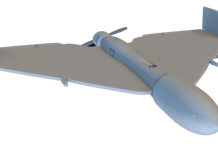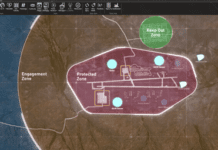
This post is also available in:
 עברית (Hebrew)
עברית (Hebrew)
The US Homeland Security has been integrating Artificial Intelligence (AI) into its various operations, initiated and overseen primarily by the S&T.
One AI technology for border security and the Customs and Border Protection Agency (CBP) operations is the Metamaterial Electronically Scanning Array (MESA) radar developed by radar tech company Echodyne. This compact and lightweight radar system uses a significantly lower amount of power, making it a portable way to scan large areas. Using the capabilities of MESA radar to detect and cue objects of interest together with AI-enabled software, it may greatly improve the CBP’s situational awareness along US borders.
Currently, the CBP is testing the effectiveness of MESA radar as the main component for cueing and detecting in autonomous surveillance towers in the San Diego sectors.
Another technology, developed by Tamr, is directed at “enhancing the entity identification and matching algorithms for GTAS” or the Global Travel Assessment System. This is a free-to-use, open source, web-based application housed in GitHub designed to screen travelers efficiently using standard Advance Passenger Information (API) and Passenger Name Record (PNR).
Tamr provided the CBP with machine learning-enhanced software to analyze the API/PNR data available in the GTAS to resolve entity identification and matching at security and border checkpoints. The idea is to increase the speed at which the GTAS can confirm the identity of a “trusted traveler” or get a “hit” on a person of interest, according to emerj.com.
Emergency response is another area where the DHS implements AI technologies. The S&T recently formed a partnership with its counterpart in neighboring Canada, in an initiative called the Next Generation First Responder (NGFR) Apex Program, which will specifically look into how to ensure better connectivity, protection, and situational awareness of first responders to emergencies and crises in both countries.
The NGFR will conduct field experiments using cutting edge, AI-based Assistant for Understanding Data through Reasoning, Extraction and Synthesis (AUDREY) system. Developed by NASA’s Jet Propulsion Laboratory, the acronym is a bit of a stretch, but AUDREY could help first responders to wade through the data to improve situational awareness. This will enable them to communicate better and make faster and better decisions in emergencies.
AI can also be applied in the DHS response to domestic terrorism threat, ensuring the safety and security of people and infrastructures within the borders of the US.
The DHS has recently approved the purchase and use of the Cognito platform developed by AI company Vectra, which specializes in mitigating cyber attacks, under its Continuous Diagnostics and Mitigation (CDM) Program. This will allow state and local government bodies as well as 66 federal agencies to monitor for cybersecurity risks to its networks and IT systems continuously.
Vectra uses AI in its Cognito platform to recognize suspicious patterns of behavior as it happens, enabling it to alert human operators to take immediate and necessary action.
The pilot testing of facial recognition software in the White House has already sparked some debate. However, a more controversial move by Homeland Security is to provide immigration and Customs Enforcement (ICE) with access to license plate records from the database of Vigilant Solutions. This could enable ICE to track vehicles in real time, raising the fear of a rash of deportations of individuals for political reasons.
While large AI companies are ready to provide the technology to “read” license plates, it is uncertain what the agency is using.

























